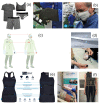Advanced and Smart Textiles during and after the COVID-19 Pandemic: Issues, Challenges, and Innovations
- PMID: 37107948
- PMCID: PMC10137734
- DOI: 10.3390/healthcare11081115
Advanced and Smart Textiles during and after the COVID-19 Pandemic: Issues, Challenges, and Innovations
Abstract
The COVID-19 pandemic has hugely affected the textile and apparel industry. Besides the negative impact due to supply chain disruptions, drop in demand, liquidity problems, and overstocking, this pandemic was found to be a window of opportunity since it accelerated the ongoing digitalization trends and the use of functional materials in the textile industry. This review paper covers the development of smart and advanced textiles that emerged as a response to the outbreak of SARS-CoV-2. We extensively cover the advancements in developing smart textiles that enable monitoring and sensing through electrospun nanofibers and nanogenerators. Additionally, we focus on improving medical textiles mainly through enhanced antiviral capabilities, which play a crucial role in pandemic prevention, protection, and control. We summarize the challenges that arise from personal protective equipment (PPE) disposal and finally give an overview of new smart textile-based products that emerged in the markets related to the control and spread reduction of SARS-CoV-2.
Keywords: COVID-19; medical textiles; smart textiles; telemedicine; textiles for diagnostic and prevention of diseases.
Conflict of interest statement
The authors declare no conflict of interest.
Figures





References
-
- COVID Live—Coronavirus Statistics—Worldometer. [(accessed on 21 July 2022)]. Available online: https://www.worldometers.info/coronavirus/
-
- Timeline COVID-19 Coronavirus—Consilium. [(accessed on 21 July 2022)]. Available online: https://www.consilium.europa.eu/en/policies/coronavirus/timeline/
-
- Ivanoska-Dacikj A., Stachewicz U. Smart Textiles and Wearable Technologies—Opportunities Offered in the Fight against Pandemics in Relation to Current COVID-19 State. Rev. Adv. Mater. Sci. 2020;59:487–505. doi: 10.1515/rams-2020-0048. - DOI
-
- European Commission, Executive Agency for Small and Medium-sized Enterprises. Izsak K., Shauchuk P. Advanced Technologies for Industry: Sectoral Watch: Technological Trends in the Textiles Industry. Publications Office; Brussels, Belgium: 2021. [(accessed on 21 July 2022)]. Available online: https://data.europa.eu/doi/10.2826/69367. - DOI
Publication types
Grants and funding
LinkOut - more resources
Full Text Sources
Miscellaneous

